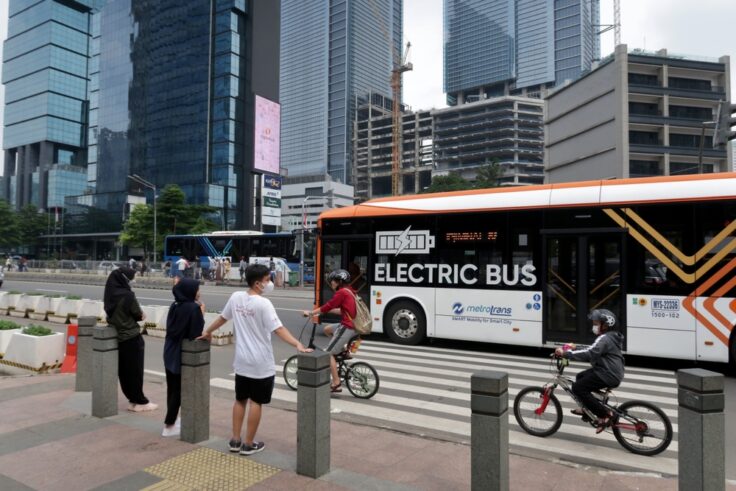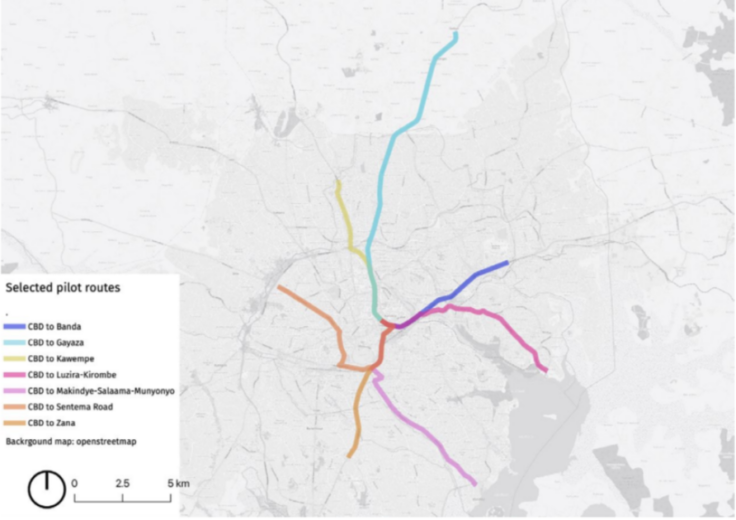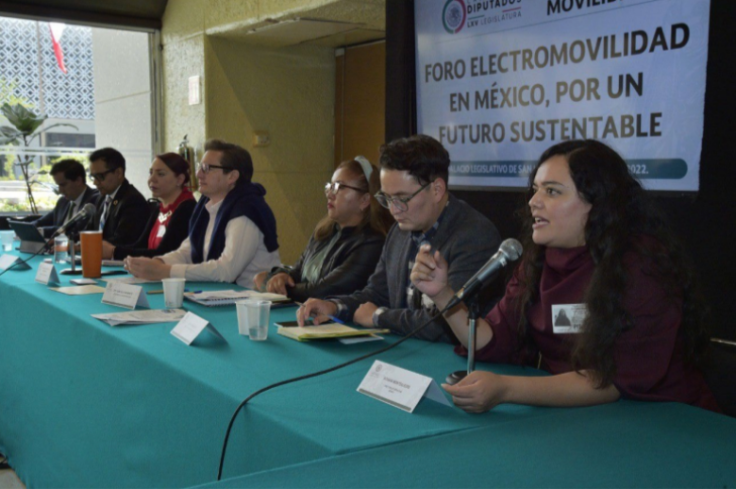December 01, 2023
E-Buses: On the Road to Lowering Emissions and Improving Public Transport
The electrification of a city’s bus fleet allows them to actively combat harmful greenhouse gas (GHG) emissions while also providing more accessible, comfortable, and efficient transport services.
Access ITDP’s in-depth report on the challenges and opportunities to scaling e-buses here.
To support e-bus adoption and transitions worldwide, ITDP has been partnering with the Transformative Urban Mobility Initiative (TUMI) E-Bus Mission since 2021 to provide support to a number of major cities: Jakarta, Indonesia; Kampala, Uganda; Monterrey, Mexico; Pune, India; and Rio de Janeiro, Brazil. Given the novelty of e-bus technology and infrastructure to many operators and cities, the sharing and exchanging of information on this work is vital to ensure that others can learn from these solutions in the context of their own cities’ systems.
By sharing useful details and practices garnered from ITDP’s work with the TUMI E-Bus Mission, we hope to help more cities combat rising GHG emissions by embracing greener, more equitable, and more sustainable development strategies. Finding tangible solutions for the transport sector will be vital to protecting people and planet in the long-term. With road transport responsible for an estimated one-quarter of global emissions currently, a global transition of urban buses to electric buses is a crucial to our future.
So, how does a city begin their e-bus transition? ITDP began exploring this issue by conducting a state of knowledge report on e-buses, combining desktop research with case studies to synthesize the state of knowledge on e-buses and their implementation. This resulted in the 2021 report, From Santiago to Shenzhen: How Electric Buses are Moving Cities, which catalogues ITDP’s exploratory work to create roadmaps for bus electrification, pilot e-buses within existing public transport systems, and address financing concerns for these new systems.

In Jakarta, new e-bus technology created opportunities to introduce other innovate elements to the city’s public transport.
Introducing E-Buses Through Planning and Piloting
The first steps for introducing e-buses into a city typically involve developing feasibility studies, assessments, roadmaps, and testing and piloting to understand how e-buses perform locally. Understanding each city’s unique needs has been crucial to developing an electrification plan that works best for them. By providing technical assistance and working closely with city officials and planners, ITDP and TUMI identified critical knowledge gaps and helped build the resources needed to speed up the implementation of e-buses. When introducing this new technology in Jakarta, Indonesia, ITDP Indonesia was the technical assistance lead, helping the Transjakarta BRT system monitor and evaluate a pilot program of 30 e-buses. The vehicles showed superior energy efficiency performance during the pilot study, and ultimately the 30 e-buses reduced an estimated 1,445 tons of CO2-eq emissions between March and December 2022. Building off the succes of the pilot study, the city is now looking towards several new targets, including:
- 100 e-buses by the end of 2023
- 50% fleet electrification (about 5,000 vehicles) by 2027
- 100% fleet electrification (over 10,000 vehicles) by 2030
Over the course of this work, ITDP realized that this new e-bus technology was also an opportunity to introduce other innovate elements to Jakarta’s public transport more broadly. For example, ITDP helped establish a data transparency protocol between Transjakarta and e-bus operators to ensure a more efficient scale-up. E-buses can generate much more data to help governments better understand planning operations, which the operators may not have shared with transport agencies otherwise.

To ensure that the benefits of e-bus were equitably distributed, ITDP also created a Gender, Equity, and Social Inclusion (GESI) Framework for Transjakarta’s e-bus planning. As part of this effort, ITDP examined the current workforce and found that men comprised 95% of e-bus drivers and 100% of technicians. Based on the e-bus planning framework, ITDP made recommendations to the larger Transjakarta GESI Plan, which recommended that operators leverage the transition to e-buses to make changes in other areas, including increasing gender diversity and employment opportunities for women. Transjakarta has accepted this recommendation and plans to implement its findings throughout the system.
As new technology gets introduced, it is an opportunity to use this as a lever to change the existing systems to better serve all people and be a more inclusive system. ITDP also found that operators needed more support for the transition and that capacity building is vital for adopting e-buses, leading to the production of a training needs assessment for operators. The assessment addressed issues related to the maintenance, operation, control, and technology aboard new e-bus models. To accelerate electrification in Jakarta, ITDP also built a shared database for ITDP and TUMI partners to store and share e-bus pilot information, lessons learned, and critical knowledge.
One of the unique challenges facing e-bus adoption in Kampala is the region’s hilly topography.
In Kampala, Uganda, ITDP Africa helped draft a feasibility study examining routes, fleet size, energy demand, and total cost of ownership (TCO) for e-buses. One of the unique challenges facing e-bus adoption in Kampala is that the metropolitan area is quite hilly, which can impact e-bus performance. ITDP examined the city’s topography as part of an e-bus feasibility assessment to identify the most viable e-bus corridors. In addition to topographical considerations, the feasibility analysis also introduced the concepts of charging infrastructure intersecting with route and service design. It further introduced e-buses as an opportunity to engage with and help the informal public transport industry transition as well.
In the feasibility report, ITDP evaluated 28 different corridors and, after assessing the length, slope, demand profile, road conditions, and charging opportunities for each, ultimately recommended seven for pilot corridors [see image below]. Because of the local environmental considerations, part of the analysis looked at the elevation profiles. It limited the choice of potential corridors to those with a slope maximum of less than 15% at any one point and, ideally, an average slope of less than 5 percent. As a result, the Kampala Capital City Authority (KCCA) developed a request for a proposal to procure 134 e-buses for these corridors.

In Rio de Janeiro, Brazil, ITDP Brazil provided technical assistance by developing two key planning documents: an E-Mobility Plan and an E-Bus Monitoring Plan. In both cases, ITDP used e-bus adoption and integration to change and challenge some existing systems by centering an equity approach in the transition. Specifically, ITDP used an intersectional approach to ensure the socioeconomic benefits of bus electrification reach working-class, primarily Black neighborhoods on the city’s periphery.
The E-Mobility Plan was created for a low-emission district with restricted access to polluting vehicles. The plan aims to ensure the low-emission district would benefit the city’s most vulnerable populations. By prioritizing electric bus routes in heavily polluted and typically low-income areas, ITDP wanted to ensure that the introduction of e-buses would be an opportunity to improve environmental and social equity in local cities. ITPD also took an intersectional and equity-centered approach to tracking progress when developing the E-Bus Monitoring Plan.
As part of implementation, ITDP evaluated the city’s Verao Verde (Green Summer) e-bus pilot project in December 2021. This pilot study, supported by ITDP and other TUMI partners, tested one 13.2-meter electric bus for two months in the area of Madureira, a predominantly low-income, Black, working-class neighborhood in the north of Rio. ITDP and other TUMI partners are monitoring results from the pilot project to help inform the city’s broader E-Mobility Plan with an equity and inclusion lens.

E-buses are more expensive to procure initially, but less expensive to operate and maintain in the long-term.
Sustaining E-Bus Adoption: Financial Strategy and Analysis
The financial model for e-buses is essentially the inverse of diesel buses. E-buses are more expensive to procure but less expensive to operate and maintain. Diesel buses are the reverse—cheaper to buy and more expensive to operate and maintain. Because of this, one of the barriers after the initial steps of planning and piloting is to figure out the financial strategy that will support and sustain e-bus adoption. To assist cities in their drive towards adoption, ITDP helped conduct financial modeling, developed tools to understand the total cost of ownership, and provided expert assistance in creating funding and financing strategies.
In Monterrey, Mexico, an updated e-bus total cost of ownership (TCO) tool was developed for the state of Nueva Leon, where Monterrey is located. Using the updated TCO tool, ITDP Mexico created 12-year financial assessments for each corridor that considered various factors, including passenger volume, projected distance, and investment and maintenance costs. This preliminary financial model helped ITDP identify the best options based on technology performance comparisons and projected emission reductions. Ultimately, the model showed that subsidies would be necessary for some years at the beginning of the operation, but in later years, e-bus implementation would result in a surplus benefiting Monterrey’s system.
The total cost of ownership is the total lifetime costs for a vehicle, including procurement, infrastructure, operations, maintenance, disposal, and financing costs. While battery electric buses (BEBs) tend to require a more considerable upfront investment, they can potentially lower TCO than traditional diesel or compressed natural gas (CNG) buses over the average bus lifetime, usually between 10 and 15 years. When considering a TCO framework for battery electric buses, cities and operators must balance higher upfront capital costs with lower operating costs.
After assessing the TCO implications with e-buses, it is possible to create electrification funding and financing plans that integrate this new financial model and uses it as a tool to start discussions on financial strategies with stakeholders.

Implementing e-buses at-scale implies a re-imagining of existing public transport systems.
For example, in Pune, India, a leader in bus electrification, ITDP India is working with the public bus authority Pune Mahanagar (PMPML) to develop the city’s electrification road map, which will include investment and funding requirements for bus operations, fleet augmentation, route selection, and charging infrastructure. In 2023, ITDP further supported Pune in negotiating tender rates for 192 e-buses.
ITDP also successfully facilitated discussions with potential financiers in Kampala, including the International Finance Corporation (IFC). These conversations introduced financing opportunities and identified challenges for financing e-buses, with ITDP preparing an adaptable model for accessing the TCO for diesel and electric buses in Kampala. Elsewhere in Jakarta, ITDP is also facilitating Transjakarta’s E-Bus Roadmap and Financing Strategy development, which is helping to elevate the understanding of e-bus financing options in Jakarta. Potential financial stakeholders like the Indonesia Ministry of Finance, World Bank, and KfW Development Bank are key partners in this effort. The Shenzhen Bus Group Company from China, which fielded the first fully electric bus fleet in 2017, was invited to to Jakarta to share knowledge on data collection, financing mechanisms, e-bus repair and maintenance, and creative business models.
And in Brazil, ITDP stated in its Technical Reference Guide for E-mobility in Brazilian Cities that implementing e-buses implies planning a new public transport system. That is why planning for and piloting e-buses, and developing new financial strategies that underpin public transport overall, are urgent and necessary. As challenging as that can be, e-buses offer numerous opportunities to improve the public transport sector as we know it, addressing everything from operations and reliability, to sustainability, equity, and inclusion.
This exciting work is just beginning and, to ensure that it continues to accelerate, ITDP will share more insights and lessons from the TUMI Mission to inspire other cities to join the movement.
View this ITDP webinar on electrification to learn more:
